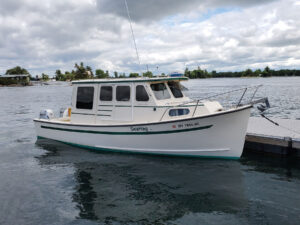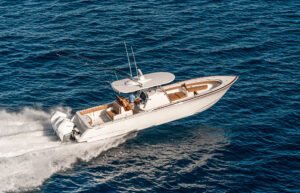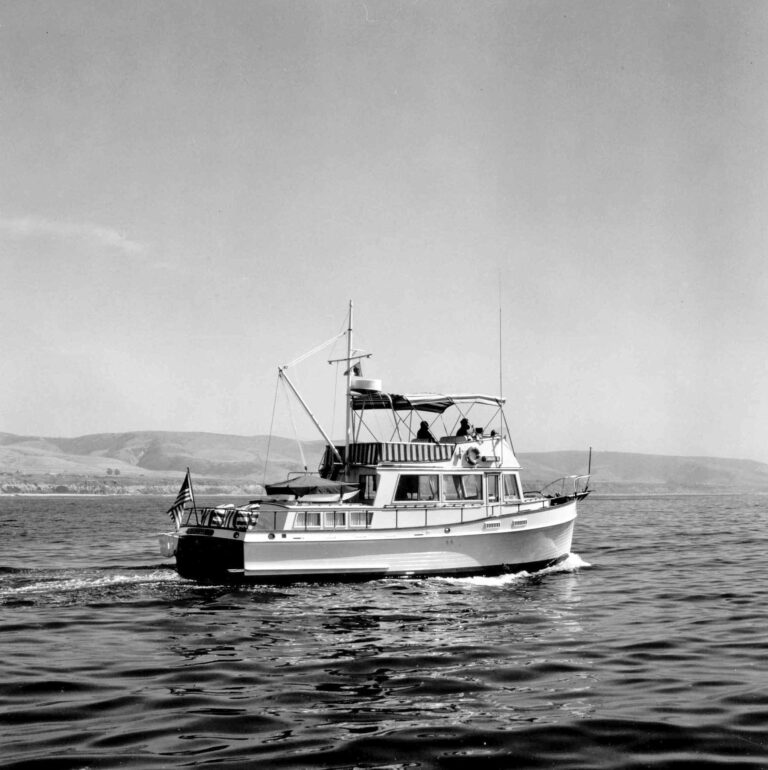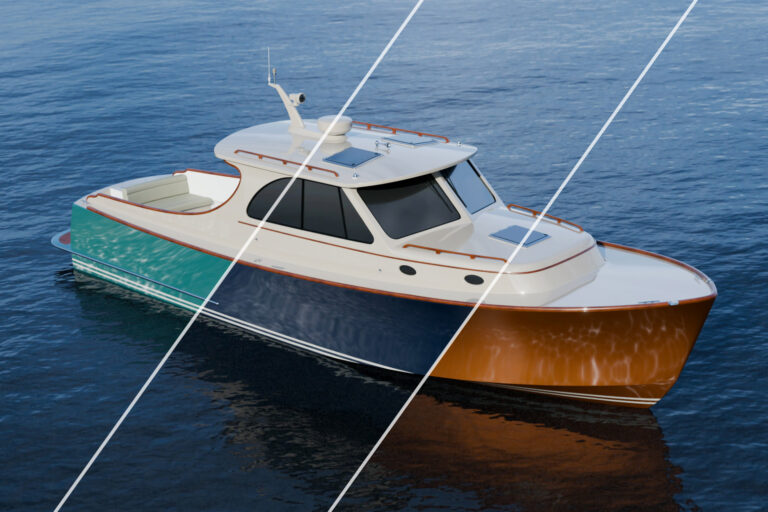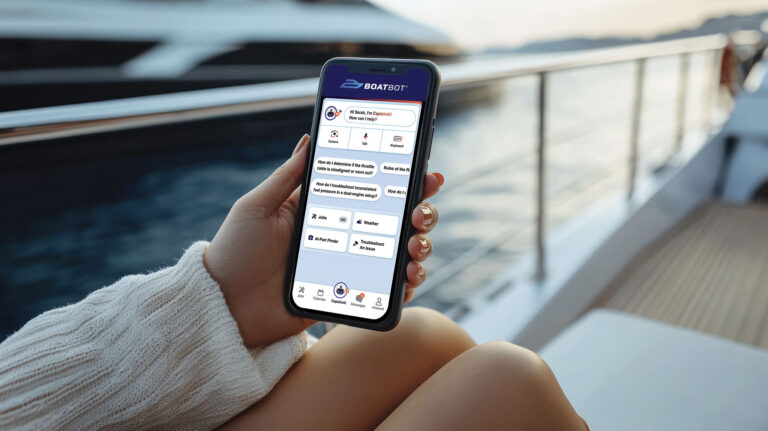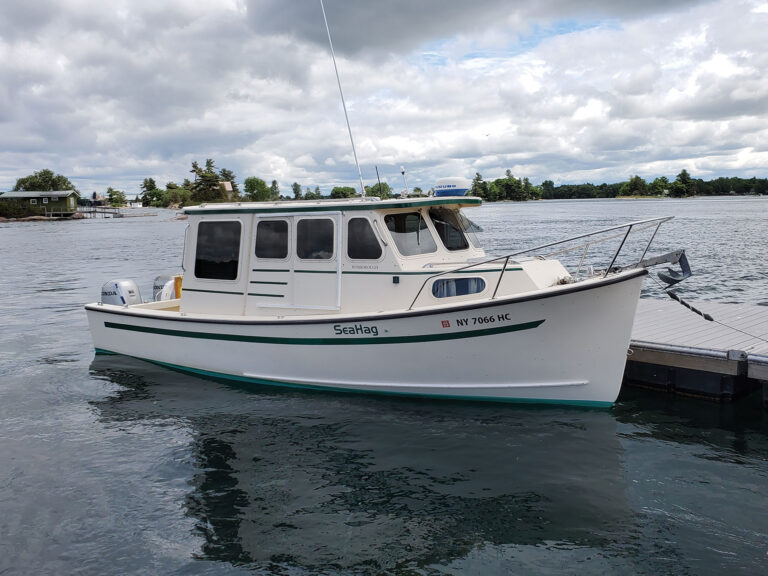IN THEIR WORDS
John Howell is old school. His great-grandfather was a ship’s captain, his father was a Long Island, N.Y., bayman, and the family boat was a Richardson 29. His grandfather spent the blizzard of 1888 on a ship frozen-in on Chesapeake Bay. Howell’s boat is old school, too, with an equally salty pedigree: a 1973 Bertram 38 Convertible that the 60-year-old retired teacher has owned for 14 years.

“It’s definitely not a Palm Beach boat,” the Port Jefferson, N.Y., angler says. “It’s 35 years old, and there are some dings and scratches. And if I get another one, big deal. I’ve got a few shark marks from offshore fishing; they just add to the conversation at cocktail hour.”
Howell bought the boat in 1994, and he’s definitely used it. He and his friends and family have fished and cruised from Peconic Bay to Nantucket, Mass., and all points in between — deep-water sharking off Montauk, N.Y., overnight striper fishing in The Race, cruising to Martha’s Vineyard or Cuttyhunk, Mass,. taking an annual trip up the Connecticut River to stay at Hamburg Cove.
“We spend a lot of time in the summer zigzagging around,” says Howell. “We do a lot of hooking, anchoring out, seeing new places, even in our own back yard.”
In fact, Howell says, his boat is what buying a used boat is all about. “If you’re on a fixed income, try and buy a new 38-footer; it’s out of the question,” he says. “But if you’re a little handy, and if you shop around, you’ll find there are good buys out there.”
Howell paid $70,000 for the boat, which had been for sale, on the hard, for two years. It was in reasonable condition, powered with twin 325-hp Cummins diesels. And it was a Bertram from the good old days, says Howell. “It had all the good Bertram hardware, and qualitywise, those boats were at the top of the list.”
His vision was to go into the six-pack charter fishing business — he has a 100-ton master’s license — and he wanted to replace his Bertram 33 with a bigger, faster, diesel boat that would fill the role. Top speed was only around 20 mph, and Howell repowered in 1997. “I did it for charter, to keep up with the competition,” he says. “Sometimes you need to do 30 on the way in, especially for tournament fishing.” (Incidentally, the reality proved less than the dream, and the charter business didn’t work out.)
After a lot of research, he chose twin 410-hp Volvo 73 TAMD diesels. Working with a surveyor and a local boatyard, Howell, who has a degree in mechanical engineering, figured out how to literally squeeze the big engines in. They had to put “bubbles” in the fiberglass hull to accommodate the oil pans.
He also bought a new generator, relocating both it and the batteries forward from their usual aft positions. He says the results were dramatic. He’d taken an estimated 3,000 pounds out of the old boat and moved the center of gravity forward. “It’s an even better head-sea boat than it was,” he says. “It cuts through the waves the way a Down Easter lobster boat does.” Howell calls the boat “sneaky fast.” Top speed is around 30 mph, and cruising speed is around 25 to 28 mph, getting just over a nautical mile to the gallon. Running at 13 to 15 mph, it delivers about 2 miles to the gallon.
Howell likes the lower station, an option on the 38. “You’re not always running up and down a ladder if you’re doing drift fishing for stripers in the rips,” he says. “And sightlines are real good; it’s a real working station.”
Cruising accommodations work out well, too. The all-electric galley has a stove, microwave and refrigerator, and enough storage so Howell can stay out for a week at a time.
“If you’re boating on a budget, like I am, take a look at the older boats. I know Hatterases, Chris-Crafts and Vikings that are 30 years old, and they look as good as the day they rolled out of the factory,” he says.
And, they’re old school.
WALKTHROUGH
The Bertram 38 Convertible rides a true deep-vee (22-degree transom deadrise) fiberglass hull designed for rough-water performance. The bow is tall, with moderate flair, and a gentle S sheer, and maintains ample freeboard all the way to the cockpit. The lines are clean, and the boat is well-balanced visually. The flybridge is reached by a port-side ladder. The steering station includes a pedestal seat and companion, and a large console has room for a variety of big-screen electronics.
The master cabin — an enclosed V-berth forward with filler — is “down” from the saloon and reached via a centerline companionway. Light and ventilation come from an overhead hatch and two ports. The adjacent head has a sink and ample counter and storage space, along with a marine head and shower. The saloon is large, with space for the galley up to port. It’s equipped with a stove top and an under-counter refrigerator, along with a large sink and enough counter space to accommodate a microwave or coffeemaker. The optional lower station replaces the standard settee to starboard, behind the triple-panel windshield.

AVAILABILITY
Different versions of the Bertram 38 Convertible can turn up almost anywhere. Prices for the mid-1970s models range from the low six figures to around $150,000 to $170,000. A well-used 1976 model in North Carolina was for sale at $125,000, with a pair of 375-hp Cat diesels (3,800 hours) for a 20-mph top end. Electronics include Furuno radar and fishfinder, Robertson autopilot, Furuno GPS and an Icom VHF. In Georgia, a 1973 model was listed at $119,900, repowered in 1992 with a pair of Cummins 6 CTA diesels with 1,900 hours. Fuel supply is an enhanced 500 gallons. The boat features a full tuna tower, new running gear, an updated interior and a yellow hull. In Mexico, a tournament-ready 38 Convertible out of Cabo San Lucas was listed “in excellent condition” at $165,000. Fishing gear “extras” included a tuna tower, Pompanette fighting chair, outriggers, and a cockpit awning.
BACKGROUND
The Bertram name is legendary in yachting. Dick Bertram was a world-class sailor and powerboat racer who popularized Ray Hunt’s then-radical deep-vee hull in the late 1950s and early ’60s. The Bertram 31, which he designed using Hunt’s hull shape, is considered one of the best powerboats ever. The 38 Convertible saw three incarnations. It was introduced in the late ’60s, revised in the early ’70s, and reprised once more as the 38 III Convertible in the late ’70s. In all, it was produced in one version or another for some 20 years, amassing a devoted fan base. It’s noted for its blend of comfort and performance, and well more than 300 were sold during its production run.
SPECIFICATIONS
LOA: 38 feet
BEAM: 14 feet, 5 inches
DRAFT: 3 feet, 6 inches
WEIGHT: 26,000 pounds
HULL TYPE: deep-vee
POWER: twin inboards
(gas or diesel)
TANKAGE: 350 gallons fuel,
100 gallons water
BUILDER: Bertram Yacht, Miami. Phone: (305) 633-8011. www.bertram.com
This story originally appeared in the January 2009 issue.


